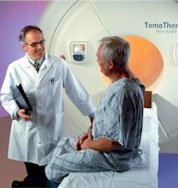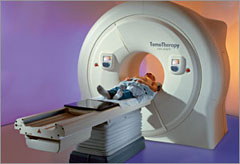About TomoTherapy
The Department of Radiation Oncology at Cooperman Barnabas Medical Center, where this new technology originates, has the combined expertise and experience to launch TomoTherapy as one of the most effective treatments for certain cancers. TomoTherapy is an advanced cancer treatment system that optimizes the delivery of radiation for cancer. It also may significantly reduce side effects, which is very important for our patients who bravely carry on their busy lives during treatment.
TomoTherapy delivers a very sophisticated form of intensity modulated radiotherapy (IMRT) with such precision that surrounding, healthy tissue receives lower doses than delivered by more conventional radiation therapy. Less damage to surrounding tissue may result in fewer complications for patients.
TomoTherapy combines precise 3-D imaging from CT scans with highly targeted radiation beams. The physician decides how much radiation the tumor should receive, as well as acceptable levels for surrounding structures. The system then calculates the appropriate pattern, position, and intensity of the radiation beam to be delivered, to match the physician's prescription as closely as possible.
The best aspect of the new system is that each patient receives a plan entirely customized to his or her tumor. The field of medicine reaches its greatest potential when a patient is treated as an individual rather than simply a body with a diagnosis. This new technology helps us to further this goal of personalized care in a powerful way.

With this new system, the physician will check the location, then deliver precise radiation therapy based on a customized plan. TomoTherapy combines precise 3-D imaging from computerized tomography (CT scanning) with highly targeted radiation beams.
Before beginning a TomoTherapy treatment, the physician uses 3-D images
and special software to establish the precise contours for each tumor
and any regions at risk, such as sensitive organs or structures.
The physician decides how much radiation the tumor should receive, as well
as acceptable levels for surrounding structures. Then the system calculates
the appropriate pattern, position, and intensity of the radiation beam
to be delivered, to match the physician's prescription as closely as possible.
For more information, please call the Department of Radiation Oncology at (973) 322-5630.




